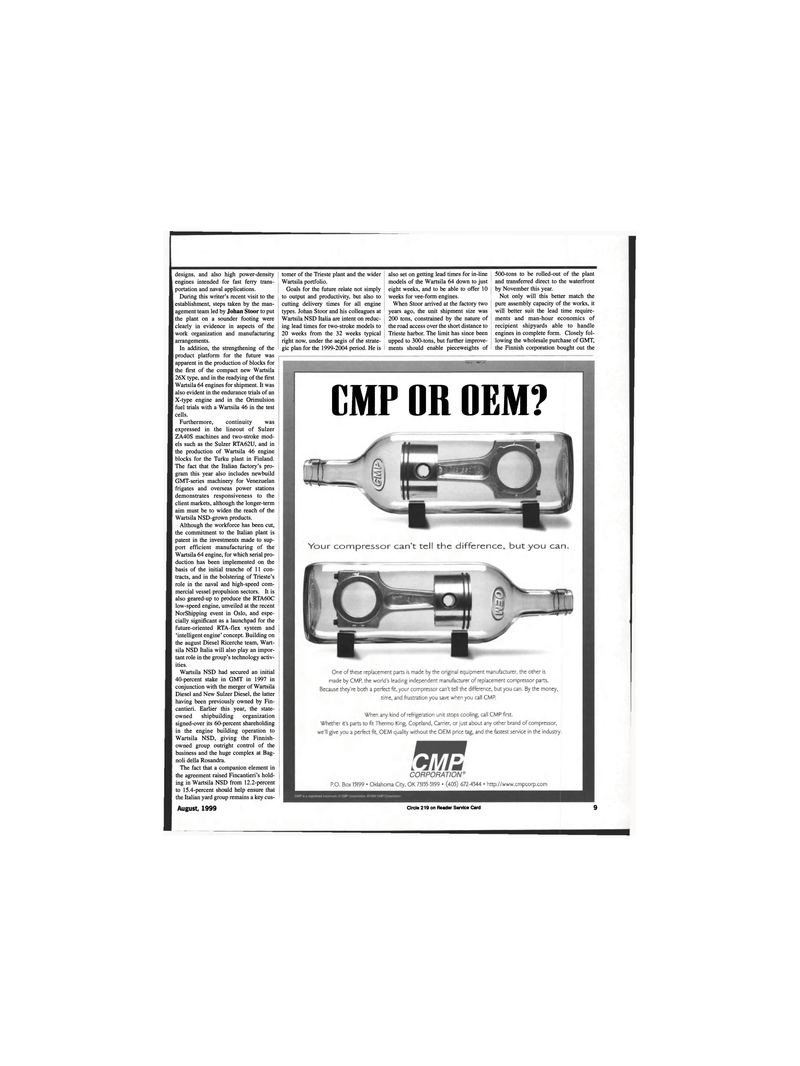
Page 9: of Maritime Reporter Magazine (August 1999)
Read this page in Pdf, Flash or Html5 edition of August 1999 Maritime Reporter Magazine
designs, and also high power-density engines intended for fast ferry trans- portation and naval applications.
During this writer's recent visit to the establishment, steps taken by the man- agement team led by Johan Stoor to put the plant on a sounder footing were clearly in evidence in aspects of the work organization and manufacturing arrangements.
In addition, the strengthening of the product platform for the future was apparent in the production of blocks for the first of the compact new Wartsila 26X type, and in the readying of the first
Wartsila 64 engines for shipment. It was also evident in the endurance trials of an
X-type engine and in the Orimulsion fuel trials with a Wartsila 46 in the test cells.
Furthermore, continuity was expressed in the lineout of Sulzer
ZA40S machines and two-stroke mod- els such as the Sulzer RTA62U, and in the production of Wartsila 46 engine blocks for the Turku plant in Finland.
The fact that the Italian factory's pro- gram this year also includes newbuild
GMT-series machinery for Venezuelan frigates and overseas power stations demonstrates responsiveness to the client markets, although the longer-term aim must be to widen the reach of the
Wartsila NSD-grown products.
Although the workforce has been cut, the commitment to the Italian plant is patent in the investments made to sup- port efficient manufacturing of the
Wartsila 64 engine, for which serial pro- duction has been implemented on the basis of the initial tranche of 11 con- tracts, and in the bolstering of Trieste's role in the naval and high-speed com- mercial vessel propulsion sectors. It is also geared-up to produce the RTA60C low-speed engine, unveiled at the recent
NorShipping event in Oslo, and espe- cially significant as a launchpad for the future-oriented RTA-flex system and 'intelligent engine' concept. Building on the august Diesel Ricerche team, Wart- sila NSD Italia will also play an impor- tant role in the group's technology activ- ities.
Wartsila NSD had secured an initial 40-percent stake in GMT in 1997 in conjunction with the merger of Wartsila
Diesel and New Sulzer Diesel, the latter having been previously owned by Fin- cantieri. Earlier this year, the state- owned shipbuilding organization signed-over its 60-percent shareholding in the engine building operation to
Wartsila NSD, giving the Finnish- owned group outright control of the business and the huge complex at Bag- noli della Rosandra.
The fact that a companion element in the agreement raised Fincantieri's hold- ing in Wartsila NSD from 12.2-percent to 15.4-percent should help ensure that the Italian yard group remains a key cus- tomer of the Trieste plant and the wider
Wartsila portfolio.
Goals for the future relate not simply to output and productivity, but also to cutting delivery times for all engine types. Johan Stoor and his colleagues at
Wartsila NSD Italia are intent on reduc- ing lead times for two-stroke models to 20 weeks from the 32 weeks typical right now, under the aegis of the strate- gic plan for the 1999-2004 period. He is also set on getting lead times for in-line models of the Wartsila 64 down to just eight weeks, and to be able to offer 10 weeks for vee-form engines.
When Stoor arrived at the factory two years ago, the unit shipment size was 200 tons, constrained by the nature of the road access over the short distance to
Trieste harbor. The limit has since been upped to 300-tons, but further improve- ments should enable pieceweights of 500-tons to be rolled-out of the plant and transferred direct to the waterfront by November this year.
Not only will this better match the pure assembly capacity of the works, it will better suit the lead time require- ments and man-hour economics of recipient shipyards able to handle engines in complete form. Closely fol- lowing the wholesale purchase of GMT, the Finnish corporation bought out the 2s: as
CMP OR OEM?
August, 1999 Circle 219 on Reader Service Card 9

 8
8

 10
10
